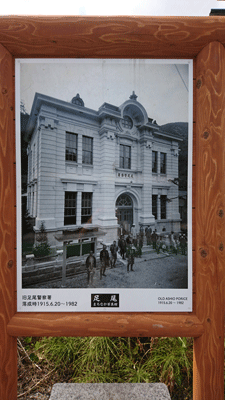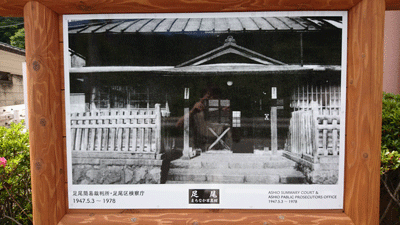産業遺産の見どころ
旧金田座 OLD KANETAZA 1903~1994

近代において、足尾銅山には多くの貸席や劇場がありました。金田座はその筆頭株です。座主の金田徳松の姓をとって命名したもので、木造二階建て、収容人数は3000人を超す規模を誇りました。
明治41年足尾銅山大観によれば、月の15日位は歌舞伎または書生芝居などが開かれ、明治30年代後半の建築と書かれています。
大正期には、片山市右エ門が経営を引き継ぎ、戦後は足尾キネマの青木氏が買収しましたが、休館にいたり放置状態でした。明治大正の労働運動の演説会場にも多く使用され、昭和時代は大型歌手が来山されました。
全盛期の座主片山市右エ門は、1884(明治17)年に生野鉱山から来山した人で、雑夫飯場銀谷(カナヤ)組を作り、大正初めに飯場を廃業しその後は興業と古物商を営みました。故作家立松和平氏の母方の御爺さまに当たります。
KANETAZA, THE ASHIOTHEATRE 1903-1994
In modern days, Ashio Copper Mine had many rooms and theaters for rent. Kanedaza; a rental space named after its owner Tokumatsu Kaneda, was one of them. The place was a two-story wooden building with a capacity of over 3,000 people.
According to the Ashio Copper Mine Daikan in 1891, Kabuki or Shosei plays were held on the 15th of each month, and the building was designed in the latter 30’s in Meji era (earlier 1900’s).
In the Taisho era, Uemon of Katayama Ichiuemon took over the managemen pitd after the war, Mr. Aoki from Ashio Kinema purchased the place after war. Unfortunately, the venue has shut down and was left unattended. Kanetaza was often used as a speech venue for the labor movement in the Meiji and Taisho eras, and famous singers has performed during the Showa period.
Katayama Ichiuemon, the owner of the venue in its golden age, came from the Ikuno Mine in 1884, and formed Zappu Hanba Kanaya group. The construction camp closed at the beginning of the Taisho era, shifting to industrial enterprise and an antique dealer shop. He is grandfather of the writer Wahei Tatematsu.
旧足尾警察署 OLD ASHIO PORICE1915.6.20~1982

足尾警察は、1878(明治11)年10月、栃木署の巡査派出所が発足し、16年10月鹿沼署足尾分署となりましたが、松原の福田氏敷地にあった派出所をそのまま分署として使用したようです。
松原から赤沢に移転したのは1890(明治23)年で、工費1026円、建坪117坪の木造庁舎でした。
足尾分署は、29年4月に鹿沼署から日光署足尾分署に組み替えられ、40年2月の足尾暴動後の3月25日に足尾警察署に昇格しました。
請願による巡査派出所は、銅山の発展に伴い申請許可がされ、明治17年本山、22年小滝、34年銀山平、39年通洞、42年赤倉鉄橋、大正2年渡良瀬、大正7年宇都野火薬庫、大正8年8月砂畑。
1819(大正8)年を皮切りに、1820(大正9)年、1821(大正10)年、1824(大正13)年と足尾銅山の争議が頻発しましたが、労働組合の勢力が強く、足尾警察署は県警本部の応援を得て争議の解決にあたり、署内で警察県本部と労働組合首脳との会談も行われました。
敗戦直後の中国人、朝鮮人の争議では、警察の力では問題解決ができず、宇都宮駐屯地の占領軍の派遣を要請し鎮静化した経緯があるようです。昭和57年10月、足尾町では維持管理が不可能との判断で惜しまれて解体されました。
FORMER AHIO POLICE STATION 1915.6.20-1982
The Ashio police station was first established in October 1878 as the local police office of Tochigi, and became Ashio local police office as a part of Kanuma police office in October 1883. The local police station building which stood in Mr. Fukuda Property, was continuously used as the local police office.
The police office was moved to Akasawa from Matsubara in 1890, a wooden building on a floor area of 117 tsubo (about 387sq ft) with a construction cost of 1026 yen.
Ashio police office became a branch of the Nikko office from that if Kanuma Office in April 1929, and was promoted to the Ashio police station on March 25th1940, after the Ashio riot tool place in February the same year.
Along with the development of the copper mine, the local police office was approved for applications, Honzan in 1884, Kodaki in 1889, Ginzandaira in1901, Tsudo in 1906, Akakura iron bridge in 1909, Watarase in 1913, Utsuno Explosives Storage Shelter in 1918, and Sunahata in August 1919.
From 1819 to 1824, there were frequent labor disputes over the Ashio Copper Mine. The labor union was had a lot of power and Ashio police station tried to settled the dispute with the support of the prefectural police headquarters. A conference was also held between the police prefectural headquarters and the leaders of the labor union.
The police could not solve the problem at the dispute happened between the Chinese and Koreans soon after the defeat of the war, the situation was settled by requesting the dispatch of the occupation forces from Camp Utsunomiya. In October 1982, the police station was dismantled for having no capability to run the facility in Ashio.
足尾簡易裁判所&足尾区検察庁 ASHIO SUMMARY COURT&ASHIO PABLIC PROSECTORS OFFICE1947.5~1978

足尾簡易裁判所は、1947(昭和22)年5月3日に上砂畑に設けられ、後に赤沢に移されました。権限は、1人の裁判官により、裁判法第33条の規定に従って、訴訟の目的の価格が10万円を超えない請求(行政事件訴訟にかかる請求を除く)、罰金以下の刑にあたる刑、法令によりその権限として付与されたものの取り扱いでした。
最初は、判事も足尾町に住み法廷も開かれていたようです。この裁判所で処理された案件は、昭和40年度221件、昭和42年度174件でしたが公判によるものはひとつも無く、いずれも書面審査でした。内容は交通違反事件が大半を占めていたようです。民間から民事事件で6名、家庭裁判所関係で4名の調停委員が選任され、調停関係で処理されたものは、昭和40年度5件、昭和41年度8件、昭和42年度5件。
足尾区検察庁は、足尾簡易裁判所と同じ沿革を持って、同一建物内にありました。昭和44年の郷土史によれば、一か月2回程度、宇都宮地方検察庁足利支部から兼務の検察官、検察事務官が来庁し、案件の処理に当たっていたようです。
ASHIO SUMMARY COURT & ASHIO PABLIC PROSECTOR’S OFFICE 1947.5-1978
The Ashio Summary Court was established in Kamisunahata on May 3, 1947 and was moved to Akasawa later. The judge was made in single person's hand and in accordance with the provisions of Article 33 of the Court Law; a claim that the price of the proceeding does not exceed 100,000 yen (excluding claims related to administrative case proceedings), a sentence equivalent to a fine or less, and a cases granted for the authority by law.
When the court was first established, the judge also lived in the town of Ashio and went to the court. The number of cases processed at this court was 221 in 1965 and 174 in 1967, yet none of them were put on trial, and all were investigated in writing. For the contents, traffic violations were majority of the cases. Six of mediation committee members were elected from the private sector for civil cases, and four were elected for cases related to domestic courts. The numbers of mediation-related cases handled was 5 in 1965, 8 in 1966, and 5 in 1967, respectively.
The Ashio Public Prosecutor's Office was established in the same year as the Ashio Summary Cour pitd located in the same building. According to the local resources from 1969, the prosecutor and the public prosecute officer were sent from the Utsunomiya Regional Prosecutor's Office, Ashikaga Branch about twice a month to handle the cases.
旧足尾中学校 OLD ASHIO JUNIUR HIGH SCHOOL1954~1991

足尾中学校は、1953(昭和28)年に3中が統合され、現在地に創立されました。
それまでは、足尾小学校に第一中学校、本山小学校に第2中学校、小滝小学校に第3中学校が誕生し小学校を分割して併設されていたのですが、1949年(昭和24)年の二中校長鈴木一氏が一中転任に伴い中学校としての独立運動が始まり実現しました。
その精神は、足尾のすべての中学生に教育の機会均等を与え、同じ学校で同じ施設を利用して学力の向上を図るということでした。当時の町長、町議会議員、会社、有志により実現に向かいました。
設計は、銅山工作課に依頼し、施設の良い他の学校を町長、町議、校長、建築技師たちが視察し、中学校の先生の希望も入れた理想的な設計図が出来、1951(昭和26)年から8000万円予算のもとに工事が進められました。1952(昭和27)年には、第1校舎、第2校舎が完成したので、先生42名、生徒1350名で開校しました。最終的に第6校舎まで建設し学びました。
1950年代は、最大50人で11クラスあった時代もあり、理科室、音楽室などの特別教室も教室として使われていた現在の新校舎は平成3年にリニューアルされました。
Ashio Junior High School was founded in 1953 at its current location after the merger of three junior high schools. The first junior high school was located at Ashio Elementary School, the second junior high school at Honzan Elementary School, and the third junior high school at Kodaki Elementary School, all of which had been located in separate elementary schools. In 1949, with the transfer of the second middle school principal, Mr. Hajime Suzuki, to the first middle school, the movement for independence as a junior high school began and was realized.
The spirit of the movement was to provide equal educational opportunities to all junior high school students in Ashio and to improve their academic performance at the same school using the same facilities. The mayor of the town at the time, town council members, the company, and volunteers worked to realize the project.
The design was commissioned to the Copper Mine Workshop Division. The mayor, town council members, school principal, and architectural engineers inspected other schools with good facilities, and with the input of the junior high school teachers' wishes, an ideal blueprint was completed. With the completion of the second school building, the school opened with 42 teachers and 1,350 students.
Eventually a sixth school building was built where students studied, and in the 1950s there were 11 classes with a maximum of 50 students. The current new school building was renovated in 1991, when the science room, music room, and other special classrooms were also used as classrooms.
停車場 TERMINAL STATION OF FURUKAWA CO.LTD HORSE TRAMWAY1891~1925&GASORINE ENGINE CAR1925~1954

江戸時代まで、人は物資の輸送手段として牛馬や人に頼っていました。明治維新後の近代化を目指した官営鉱山では、お雇い外国人の指導で輸送面でも洋式技術が導入されました。
明治2年には早くも兵庫県生野銀山や北海道の茅山鉱山では軌道が敷設され、人力や牛馬によるものですが輸送の効率化が実施されました。古河もまた、山間の足尾に自力で輸送革命のための近代設備を建設しました。
足尾で独特の発展をしたものにガソリンカーがあります。フォード自動車のエンジンを搭載した機関車でガソリンを燃料にします。大正12年横浜にフォードが入ってきました。
これに目をつけたのが古河でした。
大正14年当時の古河三代目虎之助社長が来山したおりにその第一号車が走りました。ガソリンカーは大正14年から昭和28年まで町内の軌道(トロ道)を走り、町民や銅山資材の運搬に活躍しました。
人は1番から13番まで、資材には21番、22番の大型が使われました。当時のものを復元した14番目のガソリンカーが古河足尾歴史館に併設した足尾トロッコ館で乗車することができます。
TERMINAL STATION OF FURUKAWA CO.LTD HORSE TRAMWAY 1891-1925
GASOLINE ENGINED CAR 1925-1954
Up until the Edo period, cows and horses were mainly used to transport goods. At the government-owned mine, which aimed to modernize after the Meiji restoration, Western technology was introduced under the supervision of foreign employees.
Two years into the Meiji era, rail tracks were laid at Ikuno silver mine in Hyogo and Yamatomi mine in Hokkaido, and although it still relied on man power and cows and horses, the transportation efficiency had improved by far. At Furukawa Co.ltd, people also built themselves a modern facility at the foot of the mountain for the transport reformation.
Gasoline cars are one of the items that a uniquely developed in Ashio. The locomotive was equipped with a Ford Motor engine, and was fueled by gasoline. Ford was first introduced to Yokohama in 1918.
Furukawa Co.ltd saw some potential in their technology and the first car was introduced when the third-generation CEO; Furukawa Toranosuke visited the mountain in 1914. The gasoline car ran on the railways in the town from 1914 to 1958, and was used to transport residents and materials for mining.
The Car number 1-13 were used to carry people, and the large ones numbered 21 and 22 were used to transport the materials. You can get on the 14th gasoline car, which restored the original model, at the Ashio Truck Museum next to the Furukawa Ashio History Museum.


